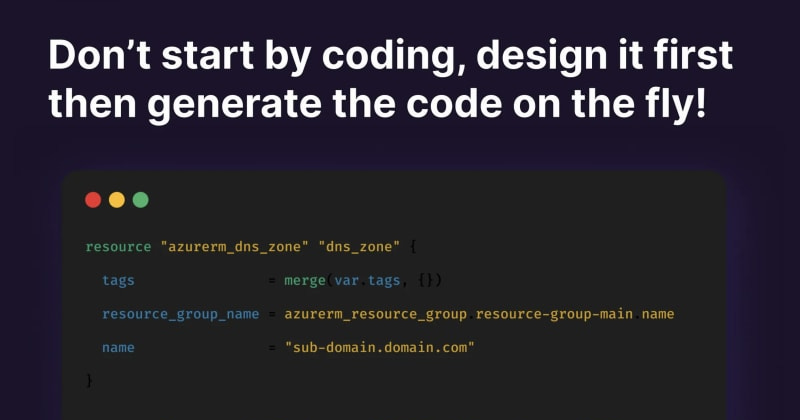In today's dynamic cloud environment, the key to success lies in meticulous planning: design first, then code. Emphasizing the critical role of a strategic design in cloud infrastructure is more relevant than ever. With Infrastructure-as-Code (IaC) becoming increasingly pivotal, bridging the gap between design and coding is essential.
This article explores the vital role of design in cloud configuration and how innovative tools like Brainboard are transforming cloud architecture design and implementation.
Infrastructure as code is now a standard.
Gone are the days of manual server, database, and network configurations. Infrastructure-as-Code has emerged as the benchmark for cloud infrastructure deployment and management. Treating infrastructure as code enables us to achieve consistency, repeatability, and scalability.
However, this shift raises a significant question: how can we effectively design and visualize our cloud infrastructure before coding it?
Why Design Matters in Infrastructure Design
“Before Brainboard, our team struggled to convey complex cloud infrastructure designs. Lengthy meetings were spent explaining concepts verbally and through basic sketches. Brainboard revolutionized this process. Its intuitive design canvas allowed us to visualize our infrastructure comprehensively, aiding understanding among technical and non-technical stakeholders alike. As the adage goes, 'Show, don't tell.' Brainboard has standardized our processes and optimized our infrastructure, marking a significant turning point for us!”
Designing your cloud architecture on a design canvas offers a clear, detailed view of your infrastructure. It allows stakeholders to grasp the complexities and interdependencies of various components.
Creating a Better Diagram
A compelling diagram is more than shapes and lines; it narrates a story and guides the viewer. Here are tips for creating standout diagrams:
- Alignment and Composition: Align and space elements evenly for aesthetic appeal and readability.
- Color and Meaning: Use colors purposefully to represent different resources or statuses.
- Effective Shape Use: Different shapes can symbolize various resources, like rectangles for servers and circles for databases.
- Visual Flow: Create a clear visual hierarchy and flow to guide the viewer's eye.
- Skeuomorphism: Use design elements resembling their real-world counterparts for intuitive understanding.
- Focus Points: Emphasize key components or pathways in your diagram.
- Versioning and Comments: Keep diagram versions and add comments to explain design choices.
A picture is worth a thousand words
Design representations of cloud infrastructure offer immense benefits, particularly for cloud architects and DevOps teams:
- Nocode Configuration: Easily configure resources and dependencies with drag-and-drop functionality.
- Rapid Prototyping: Quickly develop infrastructure designs without coding.
- Reduced Human Error: Automated code generation decreases manual error risks.
- Consistency: Maintain consistent resource configuration adhering to best practices.
- Multi-cloud Support: Design for various cloud platforms and export in respective IaC formats.
- Seamless Integration: Transition smoothly between cloud providers.
- Future-Proof Designs: Stay relevant with tools supporting multiple platforms.
- Unified Infrastructure View: Gain a comprehensive view across different cloud providers.
- Simplified Resource Configuration: Use variables for easy and consistent resource configuration.
- Scalability: Adjust infrastructure scale by modifying variable values.
- Reusability: Promote DRY principles with modular and reusable infrastructure components.
- Dynamic Configuration: Easily adapt to changing needs by updating variable values.
Incorporating design into cloud infrastructure design and management simplifies complex processes, boosting efficiency, collaboration, and decision-making.
By utilizing Brainboard, you can concentrate on designing robust, efficient cloud architectures, leaving the complexities of code generation and deployment to the tool. This approach not only speeds up infrastructure deployment but also ensures higher quality and reliability.
Design first here 👉 https://app.brainboard.co








Top comments (0)